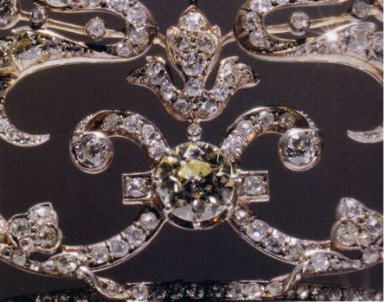Despite only existing from 1918 to 1945, The Kingdom of Yugoslavia held an impressive royal jewellery collection.
The main branch of the family may have owned the Yugoslavian Emeralds, but I would argue that the junior members of the Karađorđević clan possessed the more magnificent jewels.

.

Made in 1907 by the jeweller Boucheron for the Russian Princess Maria Pavlovna Demidova, (known as Moina).
Moina was a member of the fabulously wealthy Demidoff dynasty who owed their fortune to the discovery of rich mineral reserves in the Russian Urals and the supply of arms to the army of Peter the
Great.
She married Prince Semyon Semyonovich Abamelek-Lazarev but the couple remained childless. This would lead to them adopting Moina’s nephew, Prince Paul of Yugoslavia (First cousin to King Alexander) and make him their heir.
.


The tiara is classic of the Edwardian period featuring stylised foliage and flowers, interspersed with diamond set scroll details. Several of the Round Brilliant Cuts have been described as ‘Yellow Diamonds’ however they are more than likely M-Z colour white diamonds, usually found in larger old mine cut stones.
In 1923, Prince Paul married Princess Olga of Greece and Denmark. This marriage was particularly advantageous to Yugoslavia as Olga was related to almost all the important royal families in Europe. Her father was Prince Nicolas of Greece and her mother had been born Grand Duchess Elena Vladimirovrna of Russia, daughter of the formidable and jewel obsessed Grand Duchess Maria Pavlovna, the Grand Duchess Vladimir.
Princess Olga received many bejewelled wedding presents from her family and ‘Aunt Moina’ would gift this tiara to her. She was so touched by the generosity she made a point of stopping at Moina’s home in Venice to say thank you before heading to Belgrade for the wedding.
When King Alexander was assassinated in 1929 and Prince Paul became the regent of Yugoslavia. Due to the retirement of Queen Marie, Princess Olga became the de-facto first lady.
Along with her Diamond Kokoshnik Tiara and her Ruby Olive Wreath Parure, Princess Olga wore her Boucheron Tiara for many formal portraits and important international events.





After the fall of Yugoslavia in 1945, Prince Paul and Princess Olga went into exile, but due to Olga’s close relation to other reigning European royals, the tiara was still seen at major events.






The tiara would be inherited by her son Prince Alexander’s second wife, Princess Barbara of Lichtenstein. She was only pictured wearing it on two occasions before it was sold to the Albion Art Institute where it remains, infrequently going on display .



